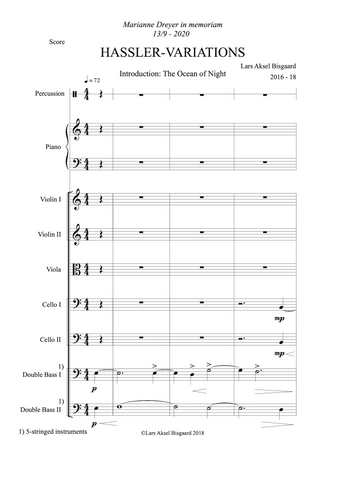Description |
Bisgaard, Lars Aksel (1947-)
|
||||||||||
Audio sample |
|||||||||||
Details |
Stadier is an attempt to unite widely divergent stylistic expressions in a single composition, without losing its overall feeling of unity. The work’s basic motif, which generates the majority of the musical material, consists of just four notes, for example A – B flat – D flat – C and its inversion (E flat – D – B – C). After a lengthy introduction where, for instance, the basic motif and its inversion are presented, there are three main sections, the character and order of which can be perceived as a musical pendant to the progression that takes place in Dante’s Divine Comedy: Inferno – Purgatory – Paradise. The first stage is a veritable inferno of semiquavers and sharply dissonant chords in conflict with each other. This section places enormous technical demands upon the pianist, who has to cope with these figures at an extremely fast tempo. At the beginning of this section Robert Schumann might perhaps have written the indication So schnell wie möglich (As fast as possible), and a little later Noch schneller (Even faster), as he did in one of his own piano sonatas—which was certainly meant ironically, as a dig at the prevalent but superficial virtuosity at the piano. In Stadier, however, there is no place for irony, although there are plenty of extreme challenges! The second section points both forwards and backwards. It begins calmly and peacefully, but later the previous atmosphere becomes more and more intrusive until in the end it is completely dominant. This process can perhaps be regarded as a musical image of the phenomena that—according to the Bardo Thödol (the Tibetan Book of the Dead)—a person encounters after death in the so-called ‘bardo’ (‘transitional’) state. First the Peaceful Ones (deities) are confronted, then the Wrathful Ones; according to the Bardo Thödol, however, these are not just two sides of the same coin but also projections of the deceased’s own mind. In Catholic theology, Purgatory is the stage at which the deceased’s soul is cleansed of its sins, so it may be pure when it enters Paradise. Here the deceased meets figures from both heaven and hell, corresponding to the person’s good and bad sides. In the end, though, light breaks through decisively, and the peace of Paradise descends upon the music, emphasized by traditional dominant seventh and dominant ninth chords. The ending of the piece, however, hints that the paradisiacal state of rest, achieved through struggle, may not be permanent, but might contain the germ of a new, similar cycle. Stadier can thus be said to imply an existential perspective on eternity. |
Loading...
Error




![Bisgaard, Lars Aksel : Stadier, Op. 1 (GPC006) [PDF Download]](http://www.artaria.com/cdn/shop/products/Stadier_grande.png?v=1571438578)
![Bisgaard, Lars Aksel : Stadier, Op. 1 (GPC006) [PDF Download]](http://www.artaria.com/cdn/shop/products/Stadier_compact.png?v=1571438578)
![Bisgaard, Lars Aksel : Stadier, Op. 1 (GPC006) [PDF Download]](http://www.artaria.com/cdn/shop/products/GP717_109b358b-b1a3-4d79-9650-ffc82c39fbd1_compact.jpg?v=1571438578)
![Bisgaard, Lars Aksel : Barcarole (GPC005) [PDF Download]](http://www.artaria.com/cdn/shop/products/Barcarole_large.png?v=1571438578)

![Bisgaard, Lars Aksel : Being (GPC004) [PDF Download]](http://www.artaria.com/cdn/shop/products/Being_large.png?v=1571438578)
![Bisgaard, Lars Aksel : Passing (GPC002) [PDF Download]](http://www.artaria.com/cdn/shop/products/Passing_large.png?v=1571438578)
![Bisgaard, Lars Aksel : Walking - Hommage à Thoreau (GPC003) [PDF Download]](http://www.artaria.com/cdn/shop/products/Walking_large.png?v=1571438578)



